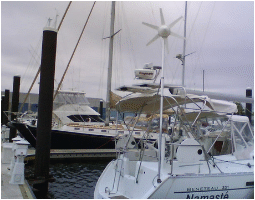 Many years ago it was easy to find all
the detailed specifications (like wattage) on the small wind generators. Over the last couple of years manufacturers have moved
away from publishing actual wattage rating of the wind generator to
now showing performance curves on a monthly or annual basis (A-Hrs or
kW-Hrs, over time).
Many years ago it was easy to find all
the detailed specifications (like wattage) on the small wind generators. Over the last couple of years manufacturers have moved
away from publishing actual wattage rating of the wind generator to
now showing performance curves on a monthly or annual basis (A-Hrs or
kW-Hrs, over time).
This is confusing and has irritated many! Limiting the average buyer from making an “apples for
apples” comparison during the purchasing process. The reality is
that the wattage rating of the wind generator does not really truly
reflect its ability to produce energy, which is what most buyers are
looking for. Energy production over time should be the true benchmark
for making a decision which one to purchase.
Smaller wind generators (lower wattage)
will usually start-up in lighter winds being able to produce energy
effectively below 15 mph. On the other hand, larger rated wind
turbines (higher wattage) are typically heavier and have a larger
wind sweep diameter (this makes sense in order to capture the energy
from the wind). They will typically not perform well in light winds
therefore capturing little or none of the energy that’s available.
In high wind conditions (typically above 15 mph) they perform very
good.
Bottom line, the energy produced
depends on the typical or average wind that the generator is
exposed to. So over a period of time, let’s say a month, a smaller wind generator sitting in light winds will typically outperform the
energy production of larger wind generators. Of course the converse
is also true, it also depends upon the design of the wind generator
and therefore it would be prudent to see and energy production curve
at various wind speeds to find out who is the true performer.
In simple terms, selection of which
wind turbine to purchase should be based on the anticipated winds one
expects to be sailing & mooring in and not on its wattage
(instantaneous power) rating. (Read How to determine if a wind turbine is a good choice for me?)
Also don’t be fooled by the wind
turbines that seemingly spin in light winds, they are just turning
(like a garden wind ornament) and not producing much in the form of
power, if any at all.